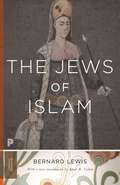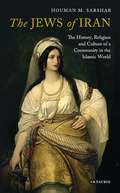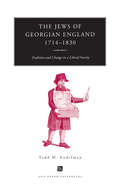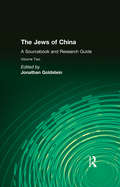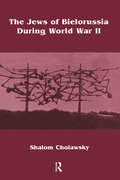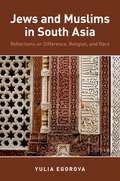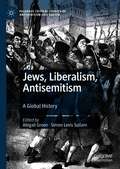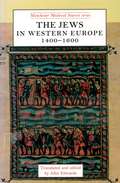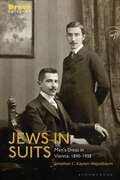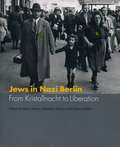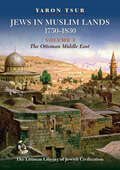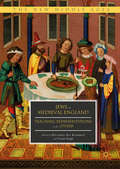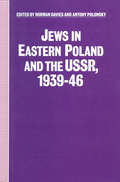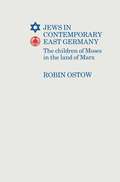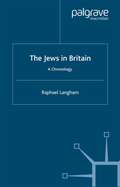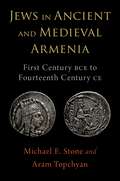- Table View
- List View
The Jews of Islam
by Bernard Lewis Mark R. CohenThis landmark book probes Muslims' attitudes toward Jews and Judaism as a special case of their view of other religious minorities in predominantly Muslim societies. With authority, sympathy and wit, Bernard Lewis demolishes two competing stereotypes: the Islamophobic picture of the fanatical Muslim warrior, sword in one hand and Qur'ān in the other, and the overly romanticized depiction of Muslim societies as interfaith utopias.Featuring a new introduction by Mark R. Cohen, this Princeton Classics edition sets the Judaeo-Islamic tradition against a vivid background of Jewish and Islamic history. For those wishing a concise overview of the long period of Jewish-Muslim relations, The Jews of Islam remains an essential starting point.
The Jews of Islam
by Bernard Lewis Mark R. CohenThis landmark book probes Muslims' attitudes toward Jews and Judaism as a special case of their view of other religious minorities in predominantly Muslim societies. With authority, sympathy and wit, Bernard Lewis demolishes two competing stereotypes: the Islamophobic picture of the fanatical Muslim warrior, sword in one hand and Qur'ān in the other, and the overly romanticized depiction of Muslim societies as interfaith utopias.Featuring a new introduction by Mark R. Cohen, this Princeton Classics edition sets the Judaeo-Islamic tradition against a vivid background of Jewish and Islamic history. For those wishing a concise overview of the long period of Jewish-Muslim relations, The Jews of Islam remains an essential starting point.
The Jews of Iran: The History, Religion and Culture of a Community in the Islamic World (International Library of Iranian Studies)
by Houman M. SarsharLiving continuously in Iran for over 2700 years, Jews have played an integral role in the history of the country. Frequently understood as a passive minority group, and often marginalized by the Zoroastrian and succeeding Muslim hegemony, the Jews of Iran are instead portrayed in this book as having had an active role in the development of Iranian history, society, and culture. Examining ancient texts, objects, and art from a wide range of times and places throughout Iranian history, as well as the medieval trade routes along which these would have travelled, The Jews of Iran offers in-depth analysis of the material and visual culture of this community. Additionally, an exploration of more modern accounts of Jewish women's experiences sheds light on the social history and transformations of the Jews of Iran from the rule of Cyrus the Great (c. 600–530 BCE) to the Iranian Revolution of 1978/9. This long view of the Jewish cultural influence on Iran's social, economic, and political development makes this book a unique contribution to the field of Judeo-Iranian studies and to the study of Iranian history.
The Jews of Georgian England, 1714-1830: Tradition and Change in a Liberal Society (Ann Arbor Paperbacks)
by Todd M. EndelmanThe movement from tradition to modernity engulfed all of the Jewish communities in the West, but hitherto historians have concentrated on the intellectual revolution in Germany by Moses Mendelssohn in the second half of the eighteenth century as the decisive event in the origins of Jewish modernity. In The Jews of Georgian England, Todd M. Endelman challenges the Germanocentric orientation of the bulk of modern Jewish historiography and argues that the modernization of European Jewry encompassed far more than an intellectual revolution. His study recounts the rise of the Anglo-Jewish elite--great commercial and financial magnates such as the Goldsmids, the Franks, Samson Gideon, and Joseph Salvador--who rapidly adopted the gentlemanly style of life of the landed class and adjusted their religious practices to harmonize with the standards of upper-class Englishmen. Similarly, the Jewish poor--peddlers, hawkers, and old-clothes men--took easily to many patterns of lower-class life, including crime, street violence, sexual promiscuity, and coarse entertainment. An impressive marshaling of fact and analysis, The Jews of Georgian England serves to illuminate a significant aspect of the Jewish passage to modernity. "Contributes to English as well as Jewish history. . . . Every reader will learn something new about the statistics, setting or mores of Jewish life in the eighteenth century. . . ." --American Historical Review Todd M. Endelman is William Haber Professor of Modern Jewish History, University of Michigan. He is also the author of Comparing Jewish Societies, Jewish Apostasy in the Modern World, and Radical Assimilation in English Jewish History, 1656-1945.
The Jews of China: v. 2: A Sourcebook and Research Guide
by Jonathan GoldsteinAn impressive interdisciplinary effort by Chinese, Japanese, Middle Eastern, and Western Sinologists and Judaic Studies specialists, these books scrutinize patterns of migration, acculturation, assimilation, and economic activity of successive waves of Jewish arrivals in China from approximately A.D.1100 to 1949.
The Jews of China: v. 2: A Sourcebook and Research Guide
by Jonathan GoldsteinAn impressive interdisciplinary effort by Chinese, Japanese, Middle Eastern, and Western Sinologists and Judaic Studies specialists, these books scrutinize patterns of migration, acculturation, assimilation, and economic activity of successive waves of Jewish arrivals in China from approximately A.D.1100 to 1949.
The Jews of Bielorussia During World War II
by Shalom CholawskyFirst Published in 1998. This study fills a gap in the history of the fate of the Jews in Bielorussia during the Holocaust. The ghettos of Bielorussia were populated by a vibrant Jewish community, with its own particular traditions, its own unique characteristics justifying our detailed examination of its fate. In general, it may be said that every region, both in Eastern Europe and in other parts of the continent, differed from its neighbors.
The Jews of Bielorussia During World War II
by Shalom CholawskyFirst Published in 1998. This study fills a gap in the history of the fate of the Jews in Bielorussia during the Holocaust. The ghettos of Bielorussia were populated by a vibrant Jewish community, with its own particular traditions, its own unique characteristics justifying our detailed examination of its fate. In general, it may be said that every region, both in Eastern Europe and in other parts of the continent, differed from its neighbors.
JEWS & MUSLIMS IN SOUTH ASIA C: Reflections on Difference, Religion, and Race
by Yulia EgorovaIn this book, Yulia Egorova explores how South Asian Jews and Muslims relate to each other outside of a Western and Christian context, and reveals that despite some important differences, the relationship is still intrinsically connected to global narratives about Jews and Muslims. She also shows how the Hindu right have turned the South Asian Jewish experience into a rhetorical tool to deny the existence of discrimination against religious minorities, and how this ostensible celebration of Jewishness masks both anti-Muslim and anti-Jewish prejudice. Jews and Muslims in South Asia is a fascinating new contribution to the academic discussion of anti-Semitism, Islamophobia, and their overlapping histories.
Jews, Liberalism, Antisemitism: A Global History (Palgrave Critical Studies of Antisemitism and Racism)
by Abigail Green Simon Levis Sullam“This is a timely contribution to some of the most pressing debates facing scholars of Jewish Studies today. It forces us to re-think standard approaches to both antisemitism and liberalism. Its geographic scope offers a model for how scholars can “provincialize” Europe and engage in a transnational approach to Jewish history. The book crackles with intellectual energy; it is truly a pleasure to read.”- Jessica M. Marglin, University of Southern California, USAGreen and Levis Sullam have assembled a collection of original, and provocative essays that, in illuminating the historic relationship between Jews and liberalism, transform our understanding of liberalism itself. - Derek Penslar, Harvard University, USA“This book offers a strikingly new account of Liberalism’s relationship to Jews. Previous scholarship stressed that Liberalism had to overcome its abivalence in order to achieve a principled stand on granting Jews rights and equality. This volume asserts, through multiple examples, that Liberalism excluded many groups, including Jews, so that the exclusion of Jews was indeed integral to Liberalism and constitutive for it. This is an important volume, with a challenging argument for the present moment.”- David Sorkin, Yale University, USAThe emancipatory promise of liberalism – and its exclusionary qualities – shaped the fate of Jews in many parts of the world during the age of empire. Yet historians have mostly understood the relationship between Jews, liberalism and antisemitism as a European story, defined by the collapse of liberalism and the Holocaust. This volume challenges that perspective by taking a global approach. It takes account of recent historical work that explores issues of race, discrimination and hybrid identities in colonial and postcolonial settings, but which has done so without taking much account of Jews. Individual essays explore how liberalism, citizenship, nationality, gender, religion, race functioned differently in European Jewish heartlands, in the Mediterranean peripheries of Spain and the Ottoman empire, and in the North American Atlantic world.
The Jews in western Europe, 1400–1600 (Manchester Medieval Sources)
by John EdwardsAs European politics, society, economy and religion underwent epoch-making changes between 1400 and 1600, the treatment of Europe's Jews by the non-Jewish majority was, then as in later periods, a symptom of social problems and tensions in the Continent as a whole. Through a broad-ranging collection of documents, John Edwards sets out to present a vivid picture of the Jewish presence in European life during this vital and turbulent period. Subjects covered include the Jews' own economic presence and culture, social relations between Jews and Christians, the policies and actions of Christian authorities in Church and State. He also draws upon original source material to convey ordinary people's prejudices about Jews, including myths about Jewish 'devilishness', money-grabbing, and 'ritual murder' of Christian children. Full introductory and explanatory material makes accessible the historical context of the subject and highlights the insights offered by the documents as well as the pitfalls to be avoided in this area of historical enquiry. This volume aims to provide a coherent working collection of texts for lecturers, teachers and students who wish to understand the experience of Jewish Europeans in this period.
The Jews in the Caribbean (The Littman Library of Jewish Civilization)
The Portuguese Jewish diaspora was born out of a double tragedy: the expulsion of the Jews from Spain in 1492 and the forced conversion/expulsion of the Jews from Portugal in 1497. The potent combination of expulsion, Inquisition, and crypto-Judaism left people neither wholly Jewish nor wholly Christian in their identity. Subsequently many left the Iberian peninsula; some found refuge in the Caribbean, but succeeded in maintaining strong connections with Portuguese Jews in western Europe, the Ottoman empire, and the Far East, while they also forged ties with the surrounding peoples and cultures. This book looks at many different aspects of this complex past. Its interdisciplinary approach allows a wealth of new information to be brought together to create a comprehensive picture. Part I sets the context, and also considers the relationship of Caribbean Jewry to European trading systems; its special ties to Amsterdam and Dutch-ruled Curaçao; and the role of Jewish merchants in Jamaica’s commerce. Part II examines the material and visual culture of Jews in the British and Dutch Caribbean, while Part III looks at Caribbean Jewish identity and heritage and their modern manifestations. Part IV contains archival studies that illuminate other subjects of importance—adventure and piracy, Jewish participation in a nineteenth-century revolt of black slaves and in the first Jamaican elections after Jews were granted the right to vote, and questions of concubinage and sexual relations between Jews and blacks. Part V moves from the local to the international, in particular the connection with mainland America. In their diversity, the contributions to this volume suggest the many ways in which the formation of the Caribbean Jewish diaspora can be understood today: as a Jewish diaspora dispersed under different European colonial empires; as a Jewish cultural entity created by a set of shared traditions and historical memories; and as one component in a web of relationships that characterized the Atlantic world. Defining it is no simple matter: like all diaspora identities it was constantly in flux, reinventing itself under changing historical circumstances. CONTRIBUTORS: Aviva Ben-Ur, Miriam Bodian, Judah M. Cohen, Eli Faber, Rachel Frankel, Noah L. Gelfand, Jane S. Gerber, Josette Capriles Goldish, Matt Goldish, Jonathan Israel, Stanley Mirvis, Gérard Nahon, Joanna Newman, Ronnie Perelis, Jackie Ranston, James Robertson, Jessica Roitman, Dale Rosengarten, Barry L. Stiefel, Hilit Surowitz-Israel, Karl Watson, Swithin Wilmot
Jews in Suits: Men's Dress in Vienna, 1890-1938 (Dress Cultures)
by Jonathan C. Kaplan-WajselbaumSurviving photographs of Jewish Viennese men during the fin-de-siècle and interwar periods – both the renowned cultural luminaries and their many anonymous coreligionists – all share a striking sartorial detail: the tailored suit. Yet, until now, the adoption of the tailored suit and its function in the formation of modern Jewish identities remains under-researched.Jews in Suits uses a rich range of written and visual sources, including literary fiction and satire, 'ego-documents', photography, trade catalogues, invoices, and department store culture, to propose a new narrative of men, fashion, and their Jewish identities. It reveals that dressing in a modern manner was not simply a matter of assimilation, but rather a way of developing new models of Jewish subjectivity beyond the externally prescribed notion of 'the Jew'. Drawing upon fashionable dress, folk costume, religious dress, avant-garde, oppositional dress, typologies which are often considered separate from one another, it proposes a new way of reading men and clothing cultures within an iconic cultural milieu, offering insights into the relationship of clothing and grooming to the understanding of the self.
Jews in Suits: Men's Dress in Vienna, 1890-1938 (Dress Cultures)
by Jonathan C. Kaplan-WajselbaumSurviving photographs of Jewish Viennese men during the fin-de-siècle and interwar periods – both the renowned cultural luminaries and their many anonymous coreligionists – all share a striking sartorial detail: the tailored suit. Yet, until now, the adoption of the tailored suit and its function in the formation of modern Jewish identities remains under-researched.Jews in Suits uses a rich range of written and visual sources, including literary fiction and satire, 'ego-documents', photography, trade catalogues, invoices, and department store culture, to propose a new narrative of men, fashion, and their Jewish identities. It reveals that dressing in a modern manner was not simply a matter of assimilation, but rather a way of developing new models of Jewish subjectivity beyond the externally prescribed notion of 'the Jew'. Drawing upon fashionable dress, folk costume, religious dress, avant-garde, oppositional dress, typologies which are often considered separate from one another, it proposes a new way of reading men and clothing cultures within an iconic cultural milieu, offering insights into the relationship of clothing and grooming to the understanding of the self.
Jews in Nazi Berlin: From Kristallnacht to Liberation (Studies in German-Jewish Cultural History and Literature, Franz Rosenzweig Minerva Research Center, Hebrew University of Jerusalem)
by Beate Meyer Hermann Simon Chana SchützThough many of the details of Jewish life under Hitler are familiar, historical accounts rarely afford us a real sense of what it was like for Jews and their families to live in the shadow of Nazi Germany’s oppressive racial laws and growing violence. With Jews in Nazi Berlin, those individual lives—and the constant struggle they required—come fully into focus, and the result is an unprecedented and deeply moving portrait of a people. Drawing on a remarkably rich archive that includes photographs, objects, official documents, and personal papers, the editors of Jews in Nazi Berlin have assembled a multifaceted picture of Jewish daily life in the Nazi capital during the height of the regime’s power. The book’s essays and images are divided into thematic sections, each representing a different aspect of the experience of Jews in Berlin, covering such topics as emigration, the yellow star, Zionism, deportation, betrayal, survival, and more. To supplement—and, importantly, to humanize—the comprehensive documentary evidence, the editors draw on an extensive series of interviews with survivors of the Nazi persecution, who present gripping first-person accounts of the innovation, subterfuge, resilience, and luck required to negotiate the increasing brutality of the regime. A stunning reconstruction of a storied community as it faced destruction, Jews in Nazi Berlin renders that loss with a startling immediacy that will make it an essential part of our continuing attempts to understand World War II and the Holocaust.
Jews in Nazi Berlin: From Kristallnacht to Liberation (Studies in German-Jewish Cultural History and Literature, Franz Rosenzweig Minerva Research Center, Hebrew University of Jerusalem)
by Beate Meyer Hermann Simon Chana C. SchützThough many of the details of Jewish life under Hitler are familiar, historical accounts rarely afford us a real sense of what it was like for Jews and their families to live in the shadow of Nazi Germany’s oppressive racial laws and growing violence. With Jews in Nazi Berlin, those individual lives—and the constant struggle they required—come fully into focus, and the result is an unprecedented and deeply moving portrait of a people. Drawing on a remarkably rich archive that includes photographs, objects, official documents, and personal papers, the editors of Jews in Nazi Berlin have assembled a multifaceted picture of Jewish daily life in the Nazi capital during the height of the regime’s power. The book’s essays and images are divided into thematic sections, each representing a different aspect of the experience of Jews in Berlin, covering such topics as emigration, the yellow star, Zionism, deportation, betrayal, survival, and more. To supplement—and, importantly, to humanize—the comprehensive documentary evidence, the editors draw on an extensive series of interviews with survivors of the Nazi persecution, who present gripping first-person accounts of the innovation, subterfuge, resilience, and luck required to negotiate the increasing brutality of the regime. A stunning reconstruction of a storied community as it faced destruction, Jews in Nazi Berlin renders that loss with a startling immediacy that will make it an essential part of our continuing attempts to understand World War II and the Holocaust.
Jews in Muslim Lands, 1750–1830: Volume I: The Ottoman Middle East (The Littman Library of Jewish Civilization)
by Yaron TsurThis fascinating tour of the Jewish communities of the Ottoman Middle East, on the eve of the changes that would come to unsettle the Ottoman territories, reveals a surprisingly varied world. Visiting Istanbul, Damascus, Acre, Jerusalem, Aleppo, Basra, and Cairo, we see different landscapes, meet diverse Jewish societies, and encounter the range of their economic activities. We also see how Christians and Jews struggled with each other to establish their position in the Muslim world and secure their livelihood. In the process, the author reconsiders fundamental questions. What is a ‘diaspora’? To what extent did the surrounding culture impact the Jewish communities of the area? And, most interestingly, how did these communities respond to the onset of modernity? Though relating to Jewish society in its entirety, the main focus is on its most powerful members: the notables, who were close to the ruling elite or involved in international trade. Tsur discusses their strengths and weaknesses, considers the relationship between their position and that of the rest of the Jewish community, and analyses their eventual downfall. His study offers new insights into the social mechanisms that enabled them to establish close ties with the ruling elite and to function within it.
Jews in Muslim Lands, 1750–1830: Volume I: The Ottoman Middle East (The Littman Library of Jewish Civilization)
by Yaron TsurThis fascinating tour of the Jewish communities of the Ottoman Middle East, on the eve of the changes that would come to unsettle the Ottoman territories, reveals a surprisingly varied world. Visiting Istanbul, Damascus, Acre, Jerusalem, Aleppo, Basra, and Cairo, we see different landscapes, meet diverse Jewish societies, and encounter the range of their economic activities. We also see how Christians and Jews struggled with each other to establish their position in the Muslim world and secure their livelihood. In the process, the author reconsiders fundamental questions. What is a ‘diaspora’? To what extent did the surrounding culture impact the Jewish communities of the area? And, most interestingly, how did these communities respond to the onset of modernity? Though relating to Jewish society in its entirety, the main focus is on its most powerful members: the notables, who were close to the ruling elite or involved in international trade. Tsur discusses their strengths and weaknesses, considers the relationship between their position and that of the rest of the Jewish community, and analyses their eventual downfall. His study offers new insights into the social mechanisms that enabled them to establish close ties with the ruling elite and to function within it.
Jews in Medieval England: Teaching Representations of the Other
by Miriamne Ara Krummel Tison PughThis volume examines the teaching of Jewishness within the context of medieval England. It covers a wide array of academic disciplines and addresses a multitude of primary sources, including medieval English manuscripts, law codes, philosophy, art, and literature, in explicating how the Jew-as-Other was formed. Chapters are devoted to the teaching of the complexities of medieval Jewish experiences in the modern classroom. Jews in Medieval England: Teaching Representations of the Other also grounds medieval conceptions of the Other within the contemporary world where we continue to confront the problematic attitudes directed toward alleged social outcasts.
Jews in Medieval England: Teaching Representations of the Other
by Miriamne Ara Krummel Tison PughThis volume examines the teaching of Jewishness within the context of medieval England. It covers a wide array of academic disciplines and addresses a multitude of primary sources, including medieval English manuscripts, law codes, philosophy, art, and literature, in explicating how the Jew-as-Other was formed. Chapters are devoted to the teaching of the complexities of medieval Jewish experiences in the modern classroom. Jews in Medieval England: Teaching Representations of the Other also grounds medieval conceptions of the Other within the contemporary world where we continue to confront the problematic attitudes directed toward alleged social outcasts.
Jews in Eastern Poland and the USSR, 1939-46 (Studies in Russia and East Europe)
by Norman Davies Antony PolonskyThis book is the first to deal with the impact on the Jews of the area of the sovietization of Eastern Poland. Polish resentment at alleged Jewish collaboration with the Soviets between 1939 and 1941 affected the development of Polish-Jewish relations under Nazi rule and in the USSR. The role of these conflicts both in the Anders army and in the Communist-led Kosciuszko division and 1st Polish Army is investigated, as well as the part played by Jews in the communist-dominated regime in Poland after 1944.
Jews in Contemporary East Germany: The Children of Moses in The Land of Marx
by Robin OstowThis book is the result of a series of interviews of Robin Ostow with Jews in the German Democratic Republic. For the first time since the founding of the East German state in 1949 Jews have been allowed to speak openly. Jewish men and women of different ages were interviewed.
The Jews in Britain: A Chronology
by R. LanghamFor nearly a thousand years there has been a Jewish presence in Britain. Today the Jewish community, although numbering less than 300,000 is widely seen as one of the most successful groups in Britain. This unique book describes events in Britain concerning Jews in chronological order, from ancient legend to the present times.
Jews in Ancient and Medieval Armenia: First Century BCE - Fourteenth Century CE
by Michael E. Stone Aram TopchyanIt was once common consensus that there was no significant Jewish community in ancient and medieval Armenia. The discovery and excavation (1997-2002) of a Jewish cemetery of the thirteenth-fourteenth centuries in southern Armenia substantially changed this picture. In this volume, Stone and Topchyan assemble evidence about the Jews of Armenia from earliest times to the fourteenth century. Based on research of the Greco-Roman period, the authors are able to draw new conclusions about the transfer of Jews--including the High Priest Hyrcanus--from the north of Palestine and other countries to Armenia by King Tigran the Great in the first century BCE. The fact that descendants of King Herod ruled in Armenia in Roman times and that some noble Armenian families may have had Jewish origin is discussed. The much-debated identification of the "Mountains of Ararat" of Noah's Ark fame as well as ancient biblical and other references to Ararat and the Caucasus are re-assessed, and new evidence is adduced that challenges the scientific consensus. The role of Jews during the Seljuk, Mongol, and later times is also presented, from surviving sources in Armenian, Arabic, Hebrew, and others. The volume also includes studies of medieval Jewish sources on Armenia and the Armenians and of communication between Armenia and the Holy Land. Documents from the Cairo Geniza, newly uncovered inscriptions, medieval itineraria, and diplomatica also throw light on Armenia in the context of the Turkic Khazar kingdom, which converted to Judaism in the latter part of the first century CE. It responds both to new archeological discoveries in Armenia and to the growing interest in the history of the region that extends north from the Euphrates and into the Caucasus.
Jews in Ancient and Medieval Armenia: First Century BCE - Fourteenth Century CE
by Michael E. Stone Aram TopchyanIt was once common consensus that there was no significant Jewish community in ancient and medieval Armenia. The discovery and excavation (1997-2002) of a Jewish cemetery of the thirteenth-fourteenth centuries in southern Armenia substantially changed this picture. In this volume, Stone and Topchyan assemble evidence about the Jews of Armenia from earliest times to the fourteenth century. Based on research of the Greco-Roman period, the authors are able to draw new conclusions about the transfer of Jews--including the High Priest Hyrcanus--from the north of Palestine and other countries to Armenia by King Tigran the Great in the first century BCE. The fact that descendants of King Herod ruled in Armenia in Roman times and that some noble Armenian families may have had Jewish origin is discussed. The much-debated identification of the "Mountains of Ararat" of Noah's Ark fame as well as ancient biblical and other references to Ararat and the Caucasus are re-assessed, and new evidence is adduced that challenges the scientific consensus. The role of Jews during the Seljuk, Mongol, and later times is also presented, from surviving sources in Armenian, Arabic, Hebrew, and others. The volume also includes studies of medieval Jewish sources on Armenia and the Armenians and of communication between Armenia and the Holy Land. Documents from the Cairo Geniza, newly uncovered inscriptions, medieval itineraria, and diplomatica also throw light on Armenia in the context of the Turkic Khazar kingdom, which converted to Judaism in the latter part of the first century CE. It responds both to new archeological discoveries in Armenia and to the growing interest in the history of the region that extends north from the Euphrates and into the Caucasus.
